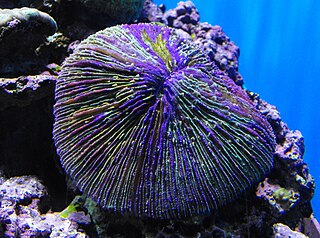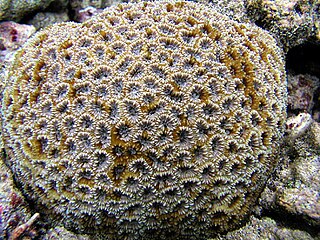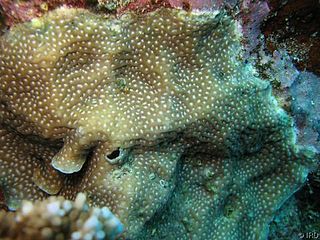
Fungia is a genus of corals in the family Fungiidae. It is monotypic with the single species Fungia fungites, which is found growing on reefs in the Indo-Pacific.

Diploastrea heliopora, commonly known as diploastrea brain coral or honeycomb coral among other vernacular names, is a species of hard coral in the family Diploastreidae. It is the only extant species in its genus. This species can form massive dome-shaped colonies of great size.

Favites is a genus of stony corals in the family Merulinidae. Members of this genus are native to the Indo-Pacific region and their ranges extend from the Red Sea through the Indian Ocean and Western Pacific Ocean as far as Japan, the Line Islands and the Tuamotu Islands.

Dipsastraea is a genus of stony corals in the family Merulinidae. Members of this genus are native to the Indo-Pacific region. They are zooxanthellate corals.

Merulina is a genus of stony corals in the family Merulinidae. Members of this genus are native to the Indo-Pacific region and their ranges extend from the Red Sea through the Indian Ocean as far as Japan and the southern central Pacific Ocean. Merulina ampliata is the type species.

Leptoria is a genus of stony corals in the family Merulinidae. Members of this genus are known as brain corals or closed brain corals. They are native to the Indo-Pacific region and their ranges extend from the Red Sea through the Indian Ocean as far as Japan and the South Central Pacific Ocean.

Herpolitha is a monotypic genus of mushroom corals in the family Fungiidae. The only member of the genus is Herpolitha limax, commonly known as the tongue, slipper, mole or striate boomerang coral. It is a free-living species and is native to reefs and lagoons in the Indo-Pacific region. The International Union for Conservation of Nature has assessed this coral as being of "least concern".

Coelastrea is a genus of stony corals in the family Merulinidae. Members of this genus are native to the Indo-Pacific region and their ranges extend from the Red Sea and the east coast of Africa through the Indian Ocean and Western Pacific Ocean as far as Australia, Japan and the East China Sea.

Ctenactis is a genus of solitary disc corals in the family Fungiidae. Members of this genus are found in the Indo-Pacific region.

Dactylotrochus is a genus of large polyp stony corals from the Red Sea and western Pacific Ocean. It is monotypic with a single species, Dactylotrochus cervicornis. It inhabits the deep sea and is believed to be azooxanthellate.

Oulophyllia crispa, sometimes called the intermediate valley coral, is a species of stony coral in the family Merulinidae. It is native to the tropical western and central Indo-Pacific region. Although this coral has a wide range, it is generally uncommon and seems to be decreasing in abundance, and the International Union for Conservation of Nature has rated its conservation status as being "near threatened".

Pavona bipartita, sometimes known as leaf coral, is a species of colonial stony coral in the family Agariciidae. It is found in shallow water, on reef slopes and on vertical surfaces, in tropical parts of the western and central Indo-Pacific region.

Pavona decussata, sometimes known as leaf coral, is a species of colonial stony coral in the family Agariciidae. It is found in shallow water in various reef habitats, particularly on gently sloping surfaces, in tropical parts of the western and central Indo-Pacific region.

Blastomussa merleti, commonly known as pineapple coral, is a species of large polyp stony coral. It is unclear in which family the genus Blastomussa belongs. This coral is native to the west and central Indo-Pacific region and is sometimes used in reef aquaria.

Goniastrea stelligera, commonly known as knob coral, is a species of stony coral in the family Merulinidae. It occurs in shallow water on the coast of East Africa and in the Indo-Pacific region. This is a common species of coral but it seems to be decreasing in abundance. The main threat it faces is from the destruction of its coral reef habitat, and it is also moderately susceptible to coral bleaching, so the International Union for Conservation of Nature has rated its conservation status as being "near threatened".

Oxypora is a genus of large polyp stony corals. Members of this genus are colonial corals and are generally foliaceous, usually with very thin leaves. They are native to the Indo-Pacific and are sometimes found in reef aquariums.

Echinophyllia is a genus of large polyp stony corals. Members of this genus are colonial corals and are generally foliaceous, usually with very thin leaves. They are native to the Indo-Pacific and are sometimes found in reef aquariums.

Pleuractis is a genus of mushroom corals in the family Fungiidae. Members of the genus are found growing on reefs in the Indo-Pacific.

Astreopora listeri is a species of hard coral found in shallow water in the tropical Indian and Pacific Oceans. It is an uncommon species with a wide range and is tolerant of turbid water, making it more resilient than some other corals to habitat disturbance. The International Union for Conservation of Nature has assessed its conservation status as being of "least concern".

Heteropsammia is a genus of apozooxanthellate corals that belong to the family Dendrophylliidae.





















